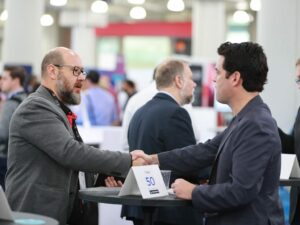We’re starting to see troubling indicators that the credit crisis, which eased as people paid off their cards during the pandemic, is creeping back up. Delinquencies rose at the 30-, 60- and 90-day marks in Q3 2023, above pre-pandemic levels, and only 33.18% of consumers paid off their balance in full that quarter, the lowest share since Q4 2020. It’s a sign that consumers are becoming more reliant on credit cards, without the resources to pay off sometimes exorbitantly high interest rates.
Of course, this isn’t exactly the news financial professionals like to hear during Financial Wellness Month. It’s more important than ever to educate consumers on alternative options to A) have their needs met and B) avoid getting trapped in a never-ending cycle of debt. In particular, we need to highlight options for unplanned or short-notice expenses, such as elective home repairs and dental procedures, that can lead consumers to make very quick and costly decisions.
One tool designed to ease these larger purchases: embedded lending, which allows consumers to apply for a loan processed by a third party – but completed directly through a merchant’s office or website. Embedded lending is unique in that while it simplifies the loan process for consumers, it also offers greater peace of mind for merchants. Here’s how the approach helps both parties.
For Consumers: More Options, Fewer Unknowns
Life is full of surprise costs that can throw a budget into chaos. Think of finding that your roof has a leak and needs to be repaired before there’s significant damage or having a crown chip, which requires unplanned dental surgery. Fewer than half of Americans can afford a $1,000 emergency expense, and, in the case of home renovations, 31% are putting off necessary repairs – with 78% of those consumers saying it’s because of rising costs. Delaying these needed costs can ultimately lead to higher expenses in the future.
With embedded lending, once a project or service estimate has been completed, consumers can start the funding process as soon as they have been approved for a loan. Users complete the application, view multiple offers, and select the payment plan that works best for them. They aren’t required to open a revolving line of credit or take out a payday/predatory loan. Interest rates are at times better than buy now, pay later programs, and the consumer’s personal information remains secure – no submitting private details and income on multiple lender websites or a merchant’s device.
Consumer benefits go beyond the lending process, however. Because some embedded lending platforms can work with lenders that consider more factors than a credit score, they can help those with financial struggles or no credit. As the consumer completes their payments, each is reported to credit bureaus much as a revolving card would, helping the consumer build a positive credit history.
For Merchants: More Sales, Fewer Risks
On the front end, an embedded lending platform reduces a merchant’s barriers between quoting a project or procedure and getting a signed contract. When it’s easier for a consumer to have their financing options before the contractor leaves the project site or the consumer leaves the provider’s office, it’s less likely they’ll decide against the project or procedure while searching for funding.
On the back end, embedded lending solves a major problem in contractor or provider work: how payment will occur. The embedded lending platform serves as a middleman between the contractor and consumer for expenses incurred during the project. Fifty four percent of contractors say material costs are a major concern for 2024, and purchasing the necessary materials can weigh heavy on the contractor’s line of credit until they’re reimbursed – maybe even months down the line.
In an embedded lending scenario, the customer receives access to funds as soon as the application is approved and accepted. The contractor sends a charge request to the customer, which they can approve or deny.
A win-win scenario
As consumers faced several years of heightened inflation, credit cards looked like a saving grace – but the impact of growing utilization is starting to show. At the same time, consumers still need access to financing in a moment of need.
Embedded lending offers an alternative to typical emergency funding that can further wreak havoc on a consumer’s finances. Even for those who have savings, it can help reduce the burden of having to pay for an entire repair or procedure upfront. At the same time, it gives the merchant the funding they need to get the job done without hassle. In an economy with an ever-growing number of options for funding, embedded lending is a solution that works for all sides of the transaction.
.pp-multiple-authors-boxes-wrapper.box-post-id-45383.pp-multiple-authors-layout-boxed.multiple-authors-target-shortcode.box-instance-id-1 .box-header-title { font-size: 20px !important; } .pp-multiple-authors-boxes-wrapper.box-post-id-45383.pp-multiple-authors-layout-boxed.multiple-authors-target-shortcode.box-instance-id-1 .box-header-title { font-weight: bold !important; } .pp-multiple-authors-boxes-wrapper.box-post-id-45383.pp-multiple-authors-layout-boxed.multiple-authors-target-shortcode.box-instance-id-1 .box-header-title { color: #000000 !important; } .pp-multiple-authors-boxes-wrapper.box-post-id-45383.pp-multiple-authors-layout-boxed.multiple-authors-target-shortcode.box-instance-id-1 .pp-author-boxes-avatar img { border-style: none !important; } .pp-multiple-authors-boxes-wrapper.box-post-id-45383.pp-multiple-authors-layout-boxed.multiple-authors-target-shortcode.box-instance-id-1 .pp-author-boxes-avatar img { border-radius: 5% !important; } .pp-multiple-authors-boxes-wrapper.box-post-id-45383.pp-multiple-authors-layout-boxed.multiple-authors-target-shortcode.box-instance-id-1 .pp-author-boxes-name a { font-size: 24px !important; } .pp-multiple-authors-boxes-wrapper.box-post-id-45383.pp-multiple-authors-layout-boxed.multiple-authors-target-shortcode.box-instance-id-1 .pp-author-boxes-name a { font-weight: bold !important; } .pp-multiple-authors-boxes-wrapper.box-post-id-45383.pp-multiple-authors-layout-boxed.multiple-authors-target-shortcode.box-instance-id-1 .pp-author-boxes-name a { color: #000000 !important; } .pp-multiple-authors-boxes-wrapper.box-post-id-45383.pp-multiple-authors-layout-boxed.multiple-authors-target-shortcode.box-instance-id-1 .pp-author-boxes-description { font-style: none !important; } .pp-multiple-authors-boxes-wrapper.box-post-id-45383.pp-multiple-authors-layout-boxed.multiple-authors-target-shortcode.box-instance-id-1 .pp-author-boxes-description { text-align: left !important; } .pp-multiple-authors-boxes-wrapper.box-post-id-45383.pp-multiple-authors-layout-boxed.multiple-authors-target-shortcode.box-instance-id-1 .pp-author-boxes-meta a span { font-size: 20px !important; } .pp-multiple-authors-boxes-wrapper.box-post-id-45383.pp-multiple-authors-layout-boxed.multiple-authors-target-shortcode.box-instance-id-1 .pp-author-boxes-meta a span { font-weight: normal !important; } .pp-multiple-authors-boxes-wrapper.box-post-id-45383.pp-multiple-authors-layout-boxed.multiple-authors-target-shortcode.box-instance-id-1 .pp-author-boxes-meta { text-align: left !important; } .pp-multiple-authors-boxes-wrapper.box-post-id-45383.pp-multiple-authors-layout-boxed.multiple-authors-target-shortcode.box-instance-id-1 .pp-author-boxes-meta a { background-color: #6adc21 !important; } .pp-multiple-authors-boxes-wrapper.box-post-id-45383.pp-multiple-authors-layout-boxed.multiple-authors-target-shortcode.box-instance-id-1 .pp-author-boxes-meta a { color: #ffffff !important; } .pp-multiple-authors-boxes-wrapper.box-post-id-45383.pp-multiple-authors-layout-boxed.multiple-authors-target-shortcode.box-instance-id-1 .pp-author-boxes-meta a:hover { color: #ffffff !important; } .pp-multiple-authors-boxes-wrapper.box-post-id-45383.pp-multiple-authors-layout-boxed.multiple-authors-target-shortcode.box-instance-id-1 .ppma-author-user_url-profile-data { color: #6adc21 !important; } .pp-multiple-authors-boxes-wrapper.box-post-id-45383.pp-multiple-authors-layout-boxed.multiple-authors-target-shortcode.box-instance-id-1 .ppma-author-twitter-profile-data span, .pp-multiple-authors-boxes-wrapper.box-post-id-45383.pp-multiple-authors-layout-boxed.multiple-authors-target-shortcode.box-instance-id-1 .ppma-author-twitter-profile-data i { font-size: 16px !important; } .pp-multiple-authors-boxes-wrapper.box-post-id-45383.pp-multiple-authors-layout-boxed.multiple-authors-target-shortcode.box-instance-id-1 .ppma-author-twitter-profile-data { background-color: #6adc21 !important; } .pp-multiple-authors-boxes-wrapper.box-post-id-45383.pp-multiple-authors-layout-boxed.multiple-authors-target-shortcode.box-instance-id-1 .ppma-author-twitter-profile-data { border-radius: 50% !important; } .pp-multiple-authors-boxes-wrapper.box-post-id-45383.pp-multiple-authors-layout-boxed.multiple-authors-target-shortcode.box-instance-id-1 .ppma-author-twitter-profile-data { text-align: center !important; } .pp-multiple-authors-boxes-wrapper.box-post-id-45383.pp-multiple-authors-layout-boxed.multiple-authors-target-shortcode.box-instance-id-1 .ppma-author-linkedin-profile-data span, .pp-multiple-authors-boxes-wrapper.box-post-id-45383.pp-multiple-authors-layout-boxed.multiple-authors-target-shortcode.box-instance-id-1 .ppma-author-linkedin-profile-data i { font-size: 16px !important; } .pp-multiple-authors-boxes-wrapper.box-post-id-45383.pp-multiple-authors-layout-boxed.multiple-authors-target-shortcode.box-instance-id-1 .ppma-author-linkedin-profile-data { background-color: #6adc21 !important; } .pp-multiple-authors-boxes-wrapper.box-post-id-45383.pp-multiple-authors-layout-boxed.multiple-authors-target-shortcode.box-instance-id-1 .ppma-author-linkedin-profile-data { border-radius: 50% !important; } .pp-multiple-authors-boxes-wrapper.box-post-id-45383.pp-multiple-authors-layout-boxed.multiple-authors-target-shortcode.box-instance-id-1 .pp-author-boxes-recent-posts-title { border-bottom-style: dotted !important; } .pp-multiple-authors-boxes-wrapper.box-post-id-45383.pp-multiple-authors-layout-boxed.multiple-authors-target-shortcode.box-instance-id-1 .pp-multiple-authors-boxes-li { border-style: solid !important; } .pp-multiple-authors-boxes-wrapper.box-post-id-45383.pp-multiple-authors-layout-boxed.multiple-authors-target-shortcode.box-instance-id-1 .pp-multiple-authors-boxes-li { color: #3c434a !important; }- SEO Powered Content & PR Distribution. Get Amplified Today.
- PlatoData.Network Vertical Generative Ai. Empower Yourself. Access Here.
- PlatoAiStream. Web3 Intelligence. Knowledge Amplified. Access Here.
- PlatoESG. Carbon, CleanTech, Energy, Environment, Solar, Waste Management. Access Here.
- PlatoHealth. Biotech and Clinical Trials Intelligence. Access Here.
- Source: https://www.fintechnexus.com/merchant-consumer-financial-wellness-embedded-lending/
- :has
- :is
- $UP
- 000
- 1
- 2020
- 2023
- 2024
- 33
- a
- above
- accepted
- access
- across
- against
- AI/ML
- All
- allows
- also
- alternative
- Americans
- an
- analytics
- and
- Application
- Apply
- approach
- approve
- approved
- ARE
- AS
- At
- avatar
- avoid
- b
- back
- background
- Balance
- barriers
- BE
- because
- becoming
- been
- before
- benefits
- BEST
- Better
- between
- Beyond
- bold
- both
- both parties
- Brian
- budget
- build
- burden
- but
- buy
- by
- CAN
- card
- Cards
- case
- Center
- Chaos
- charge
- chip
- CNN
- Co-founder
- code
- color
- complete
- Completed
- Completes
- compliance
- Concern
- Consider
- consumer
- Consumers
- contract
- Contractor
- costly
- Costs
- course
- credit
- Credit Cards
- crisis
- Crown
- CTO
- customer
- cutting-edge
- cycle
- damage
- Debt
- decide
- decisions
- delaying
- designed
- details
- device
- digital
- directly
- diverse
- domains
- done
- down
- during
- each
- ease
- easier
- economy
- educate
- efforts
- embedded
- emergency
- end
- Entire
- estimate
- Even
- EVER
- ever-growing
- exactly
- executive
- expenses
- experience
- faced
- factors
- fewer
- finance
- Finances
- financial
- financial services
- financial wellness
- financing
- finding
- For
- For Consumers
- four
- front
- Front end
- full
- funding
- Fundraising
- funds
- further
- future
- get
- getting
- gives
- Go
- grace
- greater
- Growing
- Have
- having
- he
- hear
- heavy
- heightened
- help
- helping
- helps
- High
- higher
- Highlight
- history
- Home
- hover
- How
- However
- HTML
- HTTPS
- i
- Impact
- important
- improving
- in
- Including
- Income
- incurred
- Indicators
- industry
- inflation
- information
- interest
- Interest Rates
- into
- IT
- Job
- larger
- later
- lead
- Leadership
- leak
- left
- lender
- lenders
- lending
- lending platform
- less
- levels
- like
- likely
- Line
- loan
- looked
- lowest
- major
- make
- management
- Marketing
- material
- materials
- maybe
- Merchant
- Merchants
- met
- mind
- Mission
- moment
- Month
- months
- more
- much
- multiple
- Nationwide
- necessary
- Need
- needed
- needs
- news
- no
- None
- normal
- now
- number
- occur
- of
- off
- Offers
- Office
- on
- once
- only
- open
- Options
- or
- out
- Oversight
- paid
- pandemic
- particular
- parties
- party
- Pay
- payment
- payments
- peace
- People
- percent
- personal
- pivotal
- plan
- platform
- Platforms
- plato
- Plato Data Intelligence
- PlatoData
- plays
- positive
- president
- private
- Problem
- procedure
- procedures
- process
- processed
- Product
- professionals
- Programs
- project
- provider
- provides
- purchases
- purchasing
- Putting
- Q3
- Quarter
- Quick
- Rates
- receives
- reduce
- reduces
- remains
- repair
- Reported
- request
- required
- requires
- Resources
- rising
- Risk
- risk management
- Role
- roof
- sales
- same
- saving
- Savings
- say
- saying
- scenario
- score
- searching
- secure
- see
- select
- Selling
- sends
- serves
- service
- Services
- several
- Share
- show
- Sides
- sign
- signed
- significant
- simplifies
- since
- site
- solid
- solution
- Solves
- some
- sometimes
- Soon
- span
- specializing
- start
- Starting
- Still
- Strategic
- Strategy
- Struggles
- submitting
- such
- Surgery
- surprise
- Take
- Technology
- Technology Strategy
- than
- that
- The
- The Future
- their
- Them
- These
- they
- think
- Third
- this
- those
- Through
- throw
- time
- times
- to
- tool
- transaction
- trapped
- troubling
- typical
- Ultimately
- unique
- until
- upholding
- users
- very
- View
- vision
- we
- Wealth
- Website
- websites
- weigh
- Wellness
- when
- which
- while
- WHO
- will
- Win-Win
- with
- without
- Work
- works
- would
- years
- Your
- zephyrnet









